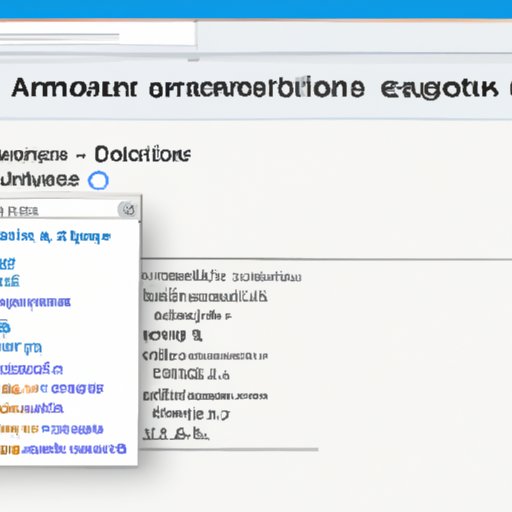Introduction
Automating browser actions is a process of automating the interactions between a web browser and a website. This allows users to programmatically control their web browsers from scripts or programs. The primary purpose of automation is to reduce the amount of manual input required to perform a task. Automation can be used to achieve a variety of tasks, from data extraction and testing to complex web browsing activities.
There are several ways to automate browser actions, including utilizing automation tools, writing macros, creating scripts, using command line tools, developing browser extensions, and exploring APIs. Each approach has its own advantages and disadvantages, and it is important to understand the differences between them in order to make an informed decision about which approach is best for a particular task.
Utilizing Automation Tools
Automation tools are software applications that allow users to programmatically control their web browsers. The two most popular automation tools are Selenium and Puppeteer. Both tools provide a set of commands that can be used to control the browser and automate tasks.
Selenium is an open-source tool that can be used to automate web browsers. It supports multiple browsers, including Chrome, Firefox, Safari, and Edge. Selenium can be used to automate a wide range of tasks, such as filling out forms, scraping data, and running tests. Selenium also provides a set of APIs that allow developers to access additional features and functionality.
Puppeteer is a Node.js library that can be used to control Chrome or Chromium. It provides a high-level API that can be used to automate a wide range of tasks, such as taking screenshots, generating PDFs, and creating automated tests. Puppeteer also provides a set of methods to control the browser, such as clicking elements, entering text, and navigating pages.
The advantages of using automation tools include flexibility, scalability, and ease of use. Automation tools are easy to set up and require minimal coding knowledge. They also provide a wide range of features and functionality that can be used to automate tasks quickly and efficiently.
Writing Macros
Macros are small programs that can be used to automate tasks in web browsers. They are written in a scripting language, such as JavaScript, and can be used to automate a wide range of tasks, such as filling out forms, extracting data, and performing calculations. Macros are often used to automate repetitive tasks that would otherwise require manual input.
The advantages of writing macros include flexibility and scalability. Macros can be used to automate complex tasks that would otherwise require manual input. They also provide a way to automate tasks quickly and efficiently. Additionally, macros can be easily modified to fit a user’s specific needs.
Creating Scripts
Scripts are small programs that can be used to automate tasks in web browsers. They are written in a programming language, such as Python, and can be used to automate a wide range of tasks, such as filling out forms, extracting data, and performing calculations. Scripts can be used to automate complex tasks that would otherwise require manual input.
The advantages of writing scripts include flexibility, scalability, and extensibility. Scripts provide a way to automate complex tasks quickly and efficiently. Additionally, scripts can be easily modified to fit a user’s specific needs. Finally, scripts can be extended to provide additional functionality.
Using Command Line Tools
Command line tools are programs that can be used to automate tasks in web browsers. They are written in a scripting language, such as Bash, and can be used to automate a wide range of tasks, such as filling out forms, extracting data, and performing calculations. Command line tools are often used to automate complex tasks that would otherwise require manual input.
The advantages of using command line tools include flexibility and scalability. Command line tools can be used to automate complex tasks quickly and efficiently. Additionally, command line tools can be easily modified to fit a user’s specific needs. Finally, command line tools provide an easy way to interact with a web browser from the command line.
Developing Browser Extensions
Browser extensions are small programs that can be used to automate tasks in web browsers. They are written in a programming language, such as JavaScript, and can be used to automate a wide range of tasks, such as filling out forms, extracting data, and performing calculations. Browser extensions can be used to automate complex tasks that would otherwise require manual input.
The advantages of developing browser extensions include flexibility and scalability. Browser extensions can be used to automate complex tasks quickly and efficiently. Additionally, browser extensions can be easily modified to fit a user’s specific needs. Finally, browser extensions provide an easy way to interact with a web browser in a familiar environment.
Exploring APIs
APIs are interfaces that can be used to automate tasks in web browsers. They are written in a programming language, such as JavaScript, and can be used to automate a wide range of tasks, such as filling out forms, extracting data, and performing calculations. APIs can be used to automate complex tasks that would otherwise require manual input.
The advantages of exploring APIs include flexibility, scalability, and extensibility. APIs provide a way to automate complex tasks quickly and efficiently. Additionally, APIs can be easily modified to fit a user’s specific needs. Finally, APIs can be extended to provide additional functionality.
Conclusion
In conclusion, there are several ways to automate browser actions, including utilizing automation tools, writing macros, creating scripts, using command line tools, developing browser extensions, and exploring APIs. Each approach has its own advantages and disadvantages, and it is important to understand the differences between them in order to make an informed decision about which approach is best for a particular task.
(Note: Is this article not meeting your expectations? Do you have knowledge or insights to share? Unlock new opportunities and expand your reach by joining our authors team. Click Registration to join us and share your expertise with our readers.)
